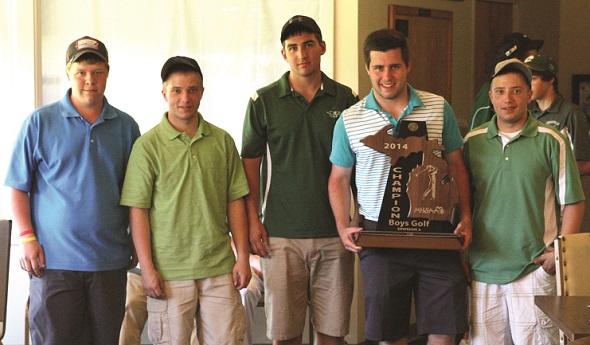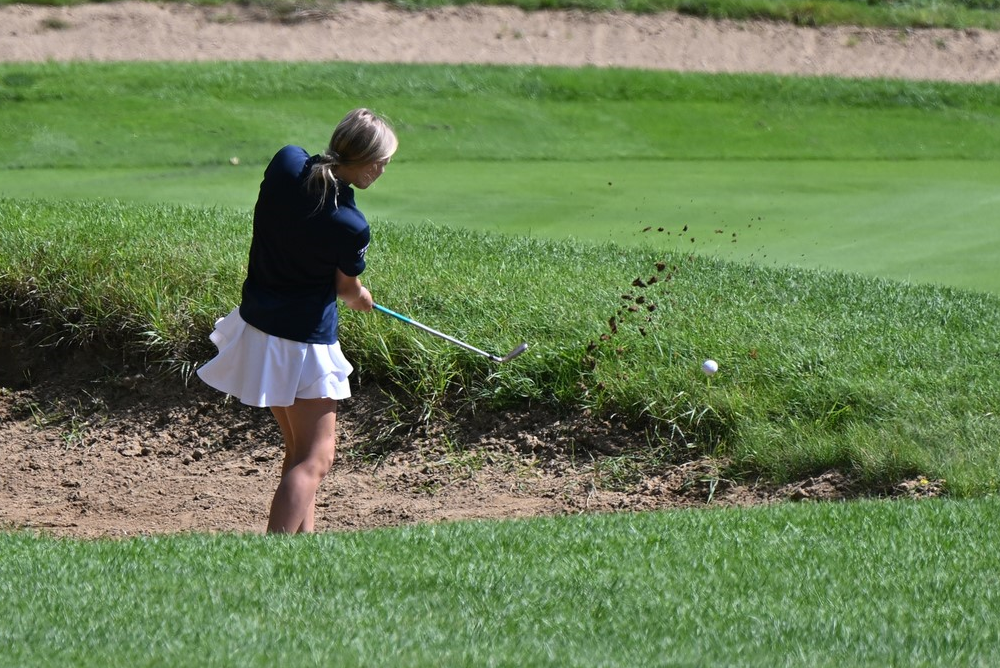
D3 Final Filled with Close Finishes
May 30, 2014
By Keith Shelton
Special to Second Half
HYDE — Two superb players with two scorching scores. Two palpitating playoff holes. One winner.
Those were the stakes at Thursday’s Upper Peninsula Division 3 Final at Highland Golf Club.
Cedarville senior Sam Eberts and Carney-Nadeau freshman Hunter Eichhorn both came in even at 71, shooting identical scores of 36 on the front nine and 35 on the back.
Neither hung around the scoreboard in the 90 minutes that followed as waves of golfers checked in. There were many good scores on the day, including a trio of 75’s. That score would have been good enough to win medalist honors in each of the past two U.P. Division 3 Finals, but not Thursday.
Inside the clubhouse, another nail-biter ensued as scores from Cedarville and Painesdale-Jeffers came in. When the dust settled, it was the Jeffers Jets by a slim margin, taking the U.P. title for the third consecutive year with a score of 314. Both teams had four golfers all at 83 or under, but Stephen Butina and Tyler Bailey’s dual 75’s were enough to put the Jets over the top. Cedarville was second at 316 followed by Carney-Nadeau at 337, Rudyard 341 and Munising 347.
Eichhorn, the young phenom from Carney, made a splash in 2013 as an eighth grader when he was runner-up on this same course. Putting together a card that was four strokes better and staying remarkably consistent throughout, he nearly still found himself in the same boat.
Eichhorn was the tactician, displaying a wealth of ability and golf knowledge. He had a seemingly large advantage from the tee box, frequently drawing “oohs” and “ahs” with his long drives of well over 200 yards.
He looked ahead on fairways with a pair of binoculars, measured distance and tested the wind with handfuls of sand, using every available piece of information to his advantage, tactics he said he picked up from watching professionals in the PGA.
“I see what they do, read the greens, test the wind, how they scout holes. I learn from watching the pros,” Eichhorn said.
On the playoff, both competitors went in confidently, playing in front of a large gallery. There was Eberts, appearing relaxed, smiling throughout and celebrating his small victories, and the stoic Eichhorn, who also enjoyed the crowd.
“It always pumps me up when there’s a crowd. The more that watch me, the better I do,” he said. “I tried to stay calm, but there’s always nerves on a playoff hole. I just tried to stay as calm as possible.”
 Each appeared to make a costly error during the playoff. Eberts drove hard to the left from the No. 10 tee box, falling just out of bounds, but he recovered incredibly well. His next shot went sailing back on course and landed just on the inside edge of the green, where he two-putted for par to force a second playoff hole.
Each appeared to make a costly error during the playoff. Eberts drove hard to the left from the No. 10 tee box, falling just out of bounds, but he recovered incredibly well. His next shot went sailing back on course and landed just on the inside edge of the green, where he two-putted for par to force a second playoff hole.
On No. 11, Eichhorn drove too hard to the right and landed amongst a cluster of trees. His next shot banked off the bark but landed in a favorable position, where had a clear shot to the green. Once there, he two-putted for a bogey. Eberts meanwhile, was in position to match with a short putt. He took his time, lined up his shot, and turned and exhaled when his ball went trickling past the hole.
Thanks to Eichhorn and Eberts however, both of their schools received a boost with their scores of 71. Carney-Nadeau finished with possibly the best MHSAA Final score in school history, coming in third at 337. For Eichhorn the team finish was more meaningful than the medalist honor.
“It was nice to win, but nice to finish third and see my team play well and compete with some of the better schools around,” he said.
The remarkably deep Jets ruled the day. Identical twins Alex and Christopher Outinen capped their team’s scores with a respective 81 and 83 on a beautiful, clear and sunny day with temperatures in the mid-70s, a welcome change from the weather Jeffers had to deal with throughout most of the season.
“We had a rough start with the weather and only having five meets under our belt,” said coach Jason Koski. “But as the year went on, the scores improved. We were in a real competitive West-PAC conference with Houghton, Calumet and Hancock. We only won one meet, but the level of competition helped — Houghton won the Division 1 Finals.
“This year, after winning the last two years, the kids had a little more confidence. I wouldn’t say they were overconfident, but they had that confidence to them this year.”
The Jets also exhibited another important quality in keeping a level head in the game of golf.
“They’re mentally strong,” Koski said. “Whenever they’d have a rough first nine, they’d pull it together on the second nine. As an example, Christopher (Outinen) had a 46 on the first nine today and ended up pulling in an 83. I always tell the kids, don’t be throwing your clubs, even when you feel like it. You forget it, and move on.”
PHOTOS: (Top) Stephen Butina of Painesdale-Jeffers holds the Upper Peninsula Division 3 championship trophy with his teammates, including, from left; Jacob Zerast, Alex Outinen, Tyler Bailey, Butina and Christopher Outinen on Thursday at Highland Golf Club. Painesdale-Jeffers shot 314 to win its third consecutive U.P. title. (Middle) Hunter Eichhorn of Carney-Nadeau watches his drive on the second playoff hole, No. 11 at Highland Golf Club. (Photos by Keith Shelton.)

Be the Referee: Animal Interference
By
Paige Winne
MHSAA Marketing & Social Media Coordinator
September 20, 2023
Be The Referee is a series of short messages designed to help educate people on the rules of different sports, to help them better understand the art of officiating, and to recruit officials.
Below is this week's segment – Animal Interference - Listen
In golf – it’s common to hear about birdies, eagles, maybe even an albatross. Or in my case, a snowman. But what if an actual animal interferes with your ball while in play?
There are two kinds of interference.
The first involves a ball still in motion. If you are putting and a squirrel darts out and stops or redirects your putt, you simply get a do-over from the original spot.
Off the green, if a moving ball is stopped or re-directed, you play the ball from where it ultimately stops.
If your ball is stopped and a seagull picks it up and carries it off – you just replace the ball to its original spot and proceed.
It doesn’t happen often, but now you know how to deal with squirrels and seagulls … in addition to birdies and eagles.
Previous Editions
Sept. 13: Feet Rule on Soccer Throw-In - Listen
Sept. 6: Volleyball Jewelry - Listen
Aug. 30: Football Rules Similarities - Listen
Aug. 23: Football Rules Differences - Listen
(PHOTO by Gary Shook.)

